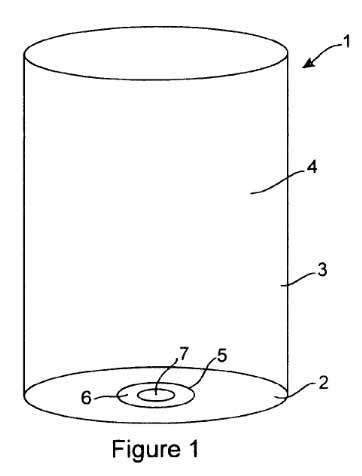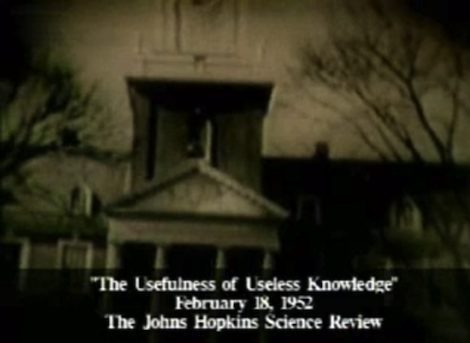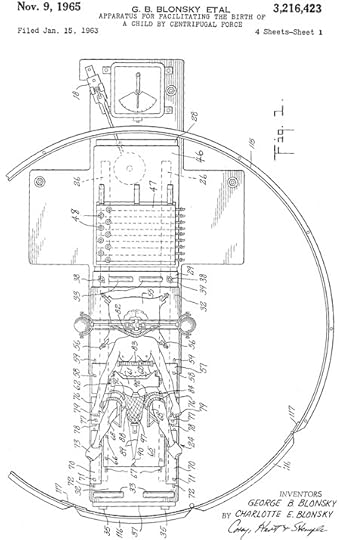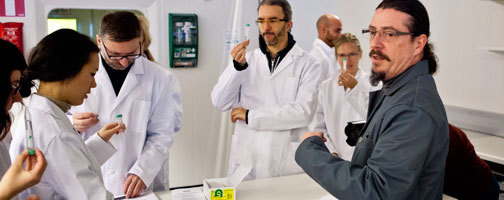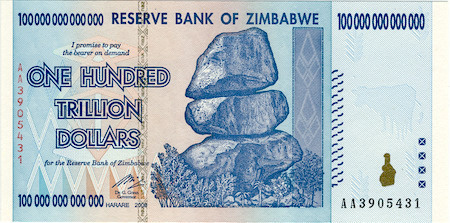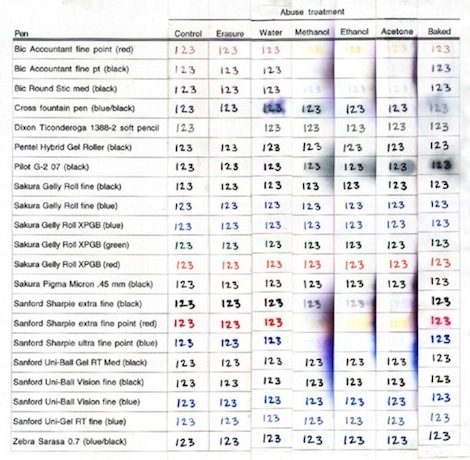Marc Abrahams's Blog, page 346
February 17, 2015
Bold experiments in human-sourced probiotics
Two recent, imaginative, slimy experiments are advancing our knowledge of how to use bacteria to make possibly-healthgiving foods.
The newest is reported by Janet Jay, writing in Motherboard:
How to Make Breakfast With Your Vagina
… Cecilia Westbrook [pictured here] is a friend of mine, and an MD/PhD student at the University of Wisconsin, Madison. We had joked before about making yogurt from vaginal secretions…. Curiosity piqued, Westbrook began to research in earnest. What choice did she have but to try it herself?
Every vagina is home to hundreds of different types of bacteria and organisms. These organisms—collectively known as the vaginal community—produce lactic acid, hydrogen peroxide, and other substances that keep the vagina healthy. The dominant bacteria is called lactobacillus, which also happens to be what people sometimes use to culture milk, cheese, and yogurt….
A slightly earlier experiment resulted in the awarding of the 2014 Ig Nobel Prize for nutrition to Raquel Rubio, Anna Jofré, Belén Martín, Teresa Aymerich, and Margarita Garriga, for their study titled “Characterization of Lactic Acid Bacteria Isolated from Infant Faeces as Potential Probiotic Starter Cultures for Fermented Sausages.” They published details of their experiment, in the journal Food Microbiology, vol. 38, 2014, pp. 303-311.
Cosmologists and their metaphors: Follicly-Challenged Stars
People who theorize about the physics of the cosmos looooove, some of them, to come up with metaphors that extend the metaphors that other cosmologists came up with. This new paper shows how that’s done:
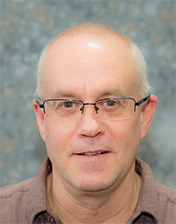
Physicist Simon Morris, who noticed the subtle extension of the lack-of-hair metaphor
“Relating Follicly-Challenged Compact Stars to Bald Black Holes,” Kent Yagi and Nicolas Yunes, arXiv:1502.04131, February 13, 2015. (Thanks to Simon Morris [pictured here] for bringing this to our attention.) The authors, at Montana State University, explain:
“Astrophysical black holes are said to have no hair because their exterior gravitational field can be completely described by only two observable quantities: their mass and their spin angular momentum. All other information or hair that may have led to the formation of the black hole is hidden inside its event horizon…. The nonapplicability of the no-hair theorem extends, in principle, to all stars, including compact ones, such as neutron stars and strange quark stars. There is therefore no reason to expect stars to be bald, i.e. for their exterior gravitational field to be independent of their internal structure…. [The] inter-relations between multipole moments correspond to compact star no-hair relations if and only if they are independent of the compact star’s internal structure, or more specifically, independent of its equation of state…. Thus, we say that compact stars are approximately bald or follicly challenged.”
February 16, 2015
Everlasting stout glass (new patent)
Inventor Charles Russell. of Dublin, Ireland, has just received a US patent (Dec, 2014) for his : ‘Drinking vessel fillable from the bottom and apparatus for dispensing a beverage therein’ The glass, which can be used for stout, or other beers, is filled (or refilled) via a special nozzle equipped with a non-return valve.
Also see: the 2007 Ig Nobel Nutrition Prize which was awarded to Brian Wansink of Cornell University, for exploring the seemingly boundless appetites of human beings, by feeding them with a self-refilling, bottomless bowl of soup.
February 15, 2015
Can rodents conceive hyperbolic spaces?
This new study is an adventure in understanding understanding:
“Can Rodents Conceive Hyperbolic Spaces?” Eugenio Urdapilleta, Francesca Troiani, Federico Stella, Alessandro Treves, arXiv1502.02435, February 9, 2015. Thanks to Mason Porter for bringing this to our attention.) The authors, at SISSA in Trieste, Italy, explain:
“The grid cells discovered in the rodent medial entorhinal cortex have been proposed to provide a metric for Euclidean space, possibly even hardwired in the embryo. Yet one class of models describing the formation of grid unit selectivity is entirely based on developmental self-organization, and as such it predicts that the metric it expresses should reflect the environment to which the animal has adapted….
“We show that, according to self-organizing models, if raised in a non-Euclidean hyperbolic cage rats should be able to form hyperbolic grids.”
February 14, 2015
Other looks at the usefulness of useless knowledge
This 1952 television broadcast at The Johns Hopkins University looked back, with dreary optimism, at Abraham Flexner‘s essay “The Usefulness of Useless Knowledge”. Flexner’s essay appeared in the October 1939 issue of Harper’s magazine [you can download that essay here.] Recently, Brainpickings took an appreciative look at Flexner and his musings.
Click on the image, and be transported via the magic of the internet to the Internet Archives, where the TV broadcast now, in a sense, lives:
(Thanks to investigator Zeke Hand for bringing the broadcast to our attention.)
BONUS: In somewhat, but nto quite, the same spirit, Kenji Kawakami’s books on Unuseless Inventions.
Improbable Research — AAAS in San Jose, Saturday Feb 14
Come to the annual Improbable Research Session at the AAAS Annual Meeting, in San Jose, California.
Saturday, February 14 (Valentine’s Day), 8:00 pm
Hilton San Jose Hotel, in the Almaden Ballroom
It’s open FREE to the public
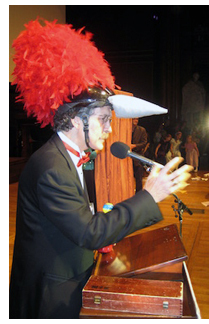
Dr. Schwab at the 2006 Ig Nobel Prize ceremony. Photo: Kees Moeliker.
The show will include, in addition to me, rare appearances by:
Dr. Ivan Schwab , Ig Nobel Prize winner (for showing why woodpeckers don’t get headaches)
Gale and Don Sturtevant, nearest living relatives of George and Charlotte Blonsky, Ig Nobel Prize winners (for inventing a device – US Patent #3,216,423 – to aid women in giving birth — the woman is strapped onto a circular table, and the table is then rotated at high speed)
Yoram Bauman , performing economist
The event always spills out the doors, so if you want a seat, get there a little early.
Please spread the word.
Here’s a glance at the patent for the Blonsky device:
BONUS NOTE TO BAY AREA JOURNALISTS: The Blonskys lived, in their final years, in the San Jose area, with the Sturtevants.
BONUS: Full schedule of Improbable Research events, including the March 2015 tour in the UK, Belgium, Denmark, and Sweden. (Luxuriant Flowing Hair Club for Scientists (LFHCfS) Man of the Year Alex Dyson will appear at the Imperial College London show, on March 20.)
February 13, 2015
DNA Spit jewellery (a most personal gift for your Valentine?)
Now that Valentine’s day is rapidly approaching, have you considered presenting a romantic partner with some jewellery made from your spit? A research project at Aalto University, Finland suggests that you could. Oron Catts and Marika Hellman of the university’s Biofilia Lab explain:
“First, some water is held in the mouth for a moment and then spit out into a test tube. A protein cleaving agent is added to the water and the test tube is placed in a water bath at the correct temperature. When a drop of alcohol is added to the test tube, the water begins to form a strange white mycelium – made from DNA taken from your own mouth.
This unusual Valentine’s Day gift is complete when the DNA is taken carefully from the test tube and placed inside a heart shaped piece of jewellery.”
See: DNA used for neck jewellery
February 12, 2015
Legislators propose medal for Gideon (“Hundred trillion dollar bill” Gono
New Zimbabwe reports, on February 12, 2015:
legislators proposed that the governor at the time, Gideon Gono be given a medal for his unorthodox efforts to rescue Zimbabwe’s beleaguered economy
Some of those extraordinary efforts led to Dr. Gono being awarded an Ig Nobel Prize. The prize citation reads:
2019 Ig Nobel Prize for Mathematics: Gideon Gono, governor of Zimbabwe’s Reserve Bank, for giving people a simple, everyday way to cope with a wide range of numbers — from very small to very big — by having his bank print bank notes with denominations ranging from one cent ($.01) to one hundred trillion dollars ($100,000,000,000,000).
REFERENCE: Zimbabwe’s Casino Economy — Extraordinary Measures for Extraordinary Challenges, Gideon Gono, ZPH Publishers, Harare, 2008, ISBN 978-079-743-679-4.
Here is one of those hundred trillion dollar bills:
Pens, pens, pens for the pensive scientist
Maryn McKenna writes (in The Further Adventures of Germ Girl ):
Ever wondered which is the best — or the worst — ink to use in your lab notebook? Wonder no more: Colin Purrington has done the work for you. Herewith, his table of inks from 20 pens (plus one pencil), subjected to erasure, heat, and splashes and soaks of water, methanol, ethanol and acetone.
Results: Bics and Sharpies do surprisingly badly, while #2 pencils stand up to everything except, umm, erasers. (True story: In journalism school, you’re taught to always carry a pencil in case you have to take notes in the rain.) And as a pen geek, I am intrigued by the brilliantly performing, and evocatively named, Sakura Pigma Micron .45.
Purrington’s account of his research is here.
February 11, 2015
Dr. Pain’s Kung Fu Kicking Robot
Dr. Pain is a Reader in Biomechanics at Loughborough University, Leicestershire, United Kingdom. His 30 yr. martial arts training undoubtedly helped in the creation of a martial arts kicking robot, which aims to faithfully replicate the roundhouse kick in Taekwondo. It was developed along with Dr. Felix Tsui, also at Loughborough.  Their paper, ‘Utilising human performance criteria and computer simulation to design a martial arts kicking robot with increased biofidelity’ in: Proceedings of the Institution of Mechanical Engineers, part p-Journal of Sports Engineering and Technology, 226(P3-4), pp.244-252 – explores how much damage a (human) roundhouse kick can do, and whether a robot can successfully deliver such a kick. It concludes :
Their paper, ‘Utilising human performance criteria and computer simulation to design a martial arts kicking robot with increased biofidelity’ in: Proceedings of the Institution of Mechanical Engineers, part p-Journal of Sports Engineering and Technology, 226(P3-4), pp.244-252 – explores how much damage a (human) roundhouse kick can do, and whether a robot can successfully deliver such a kick. It concludes :
“Multi-segment mechanical impactors can be simple yet still replicate complex human movement, such as a roundhouse kick in Taekwondo. Using simple segments and joints, data in the flexion–extension axis can be evaluated to obtain the key components of the impact. At three kick velocities (12.0, 14.0, 16.0ms21), a multisegment mathematical model was able to match the coordination of the knee and ankle at impact, producing linear velocities (as a percentage of impact velocity) at the knee (8.4%) and ankle (44.8%) which were close to human performance (7% and 47%, respectively). Moreover, introducing additional segments was able to reduce maximum stress concentrations in the impactor by ; 68%, allowing for future development. Properly addressing the coordination and masses of an impactor could help to improve upon the future design of PPE to allow evaluations to be conducted more closely to competition conditions.”
For more info, see Dr.Tsui’s thesis ‘Determining impact intensities in contact sports’
Marc Abrahams's Blog
- Marc Abrahams's profile
- 14 followers


